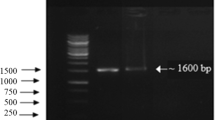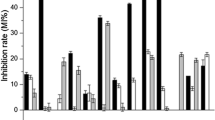Abstract
Fungal spoilage and toxic biogenic amine production is a major risk in fermented products. Therefore, the selection of nontoxic biogenic amines producing probiotic bacteria plays a vital role in the fermentation process. In the present study, a total of 18 bacterial isolates were isolated from eight different homemade pickle samples and 15 lactic acid bacteria (LAB) were identified based on biochemical tests. Out of which only seven isolates (GP1, GP2, GP3, GP4, GP5, GP9, and GP11) exhibited antifungal activity against pickle contaminant Aspergillus sp and Penicillium sp. Among the potential LAB isolates, GP11 showed the highest antifungal activity against Aspergillus sp and Penicillium sp with a zone of inhibition 28.33 ± 0.57and 19.66 ± 0.57 mm respectively. The potent LAB isolates were tested for amino acid decarboxylase activity, in which GP2, GP3, GP4, and GP5 exhibited to produce tyramine, cadaverine, and phenylethylamine while GP1 and GP5 have produced tyramine and phenylethylamine respectively. However, highly potent antifungal active isolate GP11 did not produce biogenic amine. Further, GP1, GP9, and GP11 were subjected to confirmation of biogenic amines production using HRESI-MS. HRESI-MS analysis of the GP1 and GP9 sample confirmed the presence of phenylethylamine and tyramine respectively. Interestingly, GP11 isolate did not show any biogenic amines production and GP11 was further subjected to 16S rRNA typing and identified as Lactobacillus plantarum. On in situ pickle sensory evaluation, GP11 lactopickle was graded as very good quality when compared to traditional one. Therefore L. plantarum GP11 could be developed as an ideal starter culture for the fermented production of a pickle.




Similar content being viewed by others
References
Alberto MR, Arena ME, de Nadra MCM (2002) A comparative survey of two analytical methods for identification and quantification of biogenic amines. Food Control 13:125–129
Aysun CSM, Demirkol O, Ayhan K (2017) Amino acid decarboxylase activities and biogenic amine formation abilities of lactic acid bacteria isolated from shalgam. Int J Food Prop 20:171–178. https://doi.org/10.1080/10942912.2016.1152479
Barkai-Golan R (2008) Penicillium mycotoxins. Mycotoxins Fruits Vegetables. https://doi.org/10.1016/b978-0-12-374126-4.00007-3
Bonczar G, Filipczak-Fiutak M, Pluta-Kubica A, Duda I, Walczycka M, Staruch L (2018) The range of protein hydrolysis and biogenic amines content in selected acid- and rennet-curd cheeses. Chem Pap 72:2599–2606
Bryla M, Wáskiewicz A, Podolska G, Szymczyk K, Jedrzejczak R, Damaziak K, Sułek A (2016) Occurrence of 26 mycotoxins in the grain of cereals cultivated in Poland. Toxins 8:160. https://doi.org/10.3390/toxins8060160
Cabo ML, Braber AF, Koenraad PMFJ (2002) Apparent antifungal activity of several lactic acid bacteria against Penicilliumdiscolor is due to acetic acid in the medium. J Food Protec 65:1309–1316
Capozzi V, Russo P, Ladero V, Fernández M, Fiocco D, Alvarez MA, Grieco F, Spano G (2012) Biogenic amines degradation by lactobacillus plantarum: toward a potential application in wine. Front Microbiol 3:122. https://doi.org/10.3389/fmicb.2012.00122
Cunha SC, Faria MA, Fernandes JO (2011) Gas chromatography-mass spectrometry assessment of amines in Port wine and grape juice after fast chloroformate extraction/derivatization. J Agric Food Chem 59:8742–8753
Dallal MS, Zamaniahari S, Davoodabadi A, Hosseini M, Rajabi Z (2017) Identification and characterization of probiotic lactic acid bacteria isolated from traditional Persian pickled vegetables. GMS Hyg Infect Control 12:1–8
Dangmance N, Chumkeaw N, Munkhun R, Boonson J (2015) Isolation of lactic acid bacteria from pickled cabbage for probiotic characterization. BHST 13:63–66
Dapkevicius MLE, Nout MR, Rombouts FM, Houben JH, Wymenga W (2000) Biogenic amine formation and degradation by potential fish silage starter microorganisms. Inter J Food Microbial 57:107–114
De Llano DG (1998) Biogenic amine production by wild lactococcal and leuconostoc strains. Lett Appl Microbial 26:270–274
Dereeper A, Guignon V, Blanc G, Audic S, Buffet S, Chevenet F, Dufayard JF, Guindon S, Lefort V, Lescot M, Claverie J-M, Gascuel O (2008) Phylogeny.fr: robust phylogenetic analysis for the non-specialist. Nucleic Acids Res 36:W465–469. https://doi.org/10.1093/nar/gkn180
Doeun D, Davaatseren M, Chung M-S (2017) Biogenic amines in foods. Food Sci Biotechnol 26:1463–1474
Fang F, Feng T, Du G, Chen (2016) Evaluation of the impact on food safety of a Lactobacillus coryniformis strain from pickled vegetables with degradation activity against nitrite and other undesirable compounds. Food Addit Contam Part A Chem Anal Control Expo Risk Assess 33:623–630
Garai G, Dueñas MT, Irastorza A, Moreno-Arribas MV (2007) Biogenic amine production by lactic acid bacteria isolated from cider. Lett Appl Microbiol 45:473–478
Gashe BA, Mpuchane S, Matsheka MI, Magwamba CC (2013) Biogenic amine producing bacteria associated with three different commercially fermented beverages in Botswana. Afri J Microbiol Res 7:342–350
Huh CK, Hwang TY (2016) Identification of antifungal substances of Lactobacillus sakei subsp. ALI033 and antifungal activity against Penicillium brevicompactum strain FI02. Prev Nutr Food Sci 21:52
Hussain H, MohdFuat AR, Vimala B, Ghazali HM (2011) Screening method for detection of immediate amino acid decarboxylases-producing bacteria implicated in food poisoning. Trop Biomed 28:351–361
Innocente N, Dágostin P (2002) Formation of biogenic amines in a typical semihard Italian cheese. J Food Protect 65:1498–1501
Kalagatur NK, Kamasani JR, Mudili V (2018) Assessment of detoxification efficacy of irradiation on zearalenone mycotoxin in various fruit juices by response surface methodology and elucidation of its in vitro toxicity. Front Microbiol 9:2937. https://doi.org/10.3389/fmicb.2018.02937
Kim J-D (2005) Antifungal activity of Lactic Acid Bacteria isolated from Kimchi against Aspergillus fumigatus. Mycobiology 33(4):210–214
Kongkiattikajorn J (2015) Effect of ginger extract to inhibit biogenic amines accumulation during nham fermentation. J Food Chem Nanotechnol 1:15–19
Marcia LS, Thierry A, Lemaître M, Garric G, Harel-Oger M, Chatel M, Lê S, Mounier J, Valence F, Coton E (2018) Antifungal activity of lactic acid bacteria combinations in dairy mimicking models and their potential as bioprotective cultures in pilot scale applications. Front Microbiol 9:1787. https://doi.org/10.3389/fmicb.2018.01787
MerihKivanc KS, Pektas S (2014) Screening of lactic acid bacteria for antifungal activity against fungi. J Food Process Technol 5:310. https://doi.org/10.4172/2157-7110.1000310
Moracanin SV, Stefanovic S, Radicevic T, Borovic B, Djukic D (2015) Production of biogenic amines by lactic acid bacteria isolated from Uzicka sausages. Procedia Food Sci 5:308–311
Moret S, Smela D, Populin T, Conte LS (2005) A survey of biogenic amine content of fresh and preserved vegetables. Food Chem 89:355–361
Nalazek-Rudnicka K, Wasik A (2017) Development and validation of an LC–MS/MS method for the determination of biogenic amines in wines and beers. Monatsh Chem 148:1685–1696
Önal A (2007) A review: current analytical methods for the determination of biogenic amines in foods. Food Chem 103:1475–1486
Ono H, Shoko N, Tsurii J, Kawamoto T, Sonomoto K, Nakayama J (2014) Monitoring of the microbiota profile in nukadoko, a naturally fermented rice bran bed for pickling vegetables. J Biosci Bioeng 20:1–6
Priyadarshani WD, Rakshit SK (2014) Growth and biogenic amine (histamine and tyramine) potential of probiotic Lactobacillus casei in skim milk. Am J Food Technol 9:69–79
Rodriguez MBR, Da Silva CC, Da Silva Feijó MB, Júnior CAC, Mano SB (2014) Bioactive amines: aspects of quality and safety in food. Food Nutri Sci 5:138
Sagratini G, Fernández-Franzón M, De Berardinis F, Font G, Vittori S, Mañes J (2012) Simultaneous determination of eight underivatized biogenic amines in fish by solid-phase extraction and liquid chromatography-tandem mass spectrometry. Food Chem 132:537–543
Sambrook J, Fritsch EF, Maniatis T (1989) Molecular cloning: a laboratory manual. Cold Spring Harbor Laboratory Press, New York
Sentellas S, Nunez O, Saurina J (2016) Recent advances in the determination of biogenic amines in food samples by (U) HPLC. J Agric Food Chem 64:7667–7678
Shiling L, Caihong J, Xinglian X, Chengjian X, Kaixiong L, Ruihua S (2015) Improved screening procedure for Biogenic amine production by Lactic Acid Bacteria and Enterobacteria. Czech J Food Sci 33:1–8
Singh VP, Pathak V, Verma AK (2012) Fermented meat products: organoleptic qualities and biogenic amines–a review. Am J Food Technol 7:278–288. https://doi.org/10.3923/ajft.2012.278.288
Swamy CT, Gayathri D, Devaraja TN, Bandekar M, D’Souza SE, Meena RM, Ramaiah N (2016) Plant growth promoting potential and phylogenetic characteristics of a lichenized nitrogen fixing bacterium Enterobacter cloacae. JBM 56:1369–1379
Xue H, Huaxi Y, Lanwei Z, Weiwei H, Yingchun Z, Lili Z, Ming D (2014) Improvement of fermented chinese cabbage characteristics by selected starter cultures. J Food Sci. https://doi.org/10.1111/1750-3841.12495
Yu J, Gao W, Qing M, Sun Z, Wang W, Liu W, Pan P, Sun T, Wang H, Bai N, Zhang H (2012) Identification and characterization of lactic acid bacteria isolated from traditional pickles in Sichuan, China. J Gen Appl Microbio 58:163–172
Author information
Authors and Affiliations
Contributions
P V Research student, executed the planned experimental work. A R Helped in analysing data. D G Research supervisor, developed the idea, planned the experimental design and prepared the manuscript. M V Helped in the experimentation process and manuscript preparation.
Corresponding author
Ethics declarations
Conflict of interest
Authors declare that ‘There is no conflict of interest among authors or instition or any other materials’.
Ethical approval
There is no ethical issues exist in this research work as there are no animals involved in the studies.
Additional information
Publisher's Note
Springer Nature remains neutral with regard to jurisdictional claims in published maps and institutional affiliations.
Rights and permissions
About this article
Cite this article
Priyanka, V., Ramesha, A., Gayathri, D. et al. Molecular characterization of non-biogenic amines producing Lactobacillus plantarum GP11 isolated from traditional pickles using HRESI-MS analysis. J Food Sci Technol 58, 2216–2226 (2021). https://doi.org/10.1007/s13197-020-04732-8
Revised:
Accepted:
Published:
Issue Date:
DOI: https://doi.org/10.1007/s13197-020-04732-8




